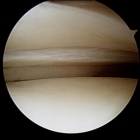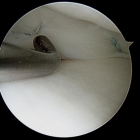Injuries to the meniscal cartilages are among the most common causes of pain in the knee. The meniscal cartilages (often called simply the cartilages or meniscus) are shock absorbers in the knee. There are two meniscal cartilages in each knee, a medial meniscus on the inside of the knee and a lateral meniscus on the outside.
The meniscal cartilage is a half moon shaped piece of tissue that lies between the weight bearing surfaces of the knee. The function of the meniscal cartilages is to evenly distribute load across the knee joint.
Tears to the meniscal cartilage in younger people are usually the result of significant injury to the knee. These injuries often occur during sporting activity and may be associated with damage to other structures around the knee, such as ligament tears.
With age the meniscal cartilages may degenerate and become friable. In this case the meniscal cartilage may tear with only a minor injury, or even with normal activity.
Symptoms
The most common symptom caused by a torn meniscal cartilage is pain. This is often felt on the side of the knee where the cartilage is located. At other times it may be generalised about the knee.
The pain is often made worse by certain activities for example squatting, twisting, stairs or running.
Swelling in the knee often occurs with meniscal tears.
Occasionally the knee can become locked. This occurs when a piece of the torn meniscal cartilage becomes jammed in between the weight bearing surfaces of the knee. This is often very uncomfortable and usually stops the knee from fully straightening.
Treatment
The meniscal cartilage has a very poor blood supply in adults, even in children the blood supply is poor. Because of this a meniscal cartilage tear usually does not heal. Surgery is often required.
The options for painful meniscal cartilage tears are either repair of the tear or removal of the torn portion of the meniscus.
Most tears to the meniscal cartilages are treated by removing the torn portion.
In young patients with certain types of meniscal cartilage tear, meniscal repair can be attempted.
Repairing the torn meniscal cartilage is usually performed by arthroscopy (keyhole surgery to the knee), although sometimes open surgery is required.
The decision of whether to repair a torn meniscal cartilage or to remove it involves many factors. These include age, type of tear, presence of ligament injuries and patient preference.
The younger the patient the more likely that repair of the meniscal cartilage will be successful. Younger patients especially children have a better blood supply to the meniscal cartilage.
Some meniscal cartilage tears are not able to be repaired, this may be obvious on an MRI scan, but sometimes will only become obvious during the procedure.
Meniscal cartilage tears that occur in isolation have a low chance of healing. Even with a young patient and a straight forward tear the chances of a repair being successful are about 30%. Despite this it is often reasonable to attempt repair in the young patient.
Meniscal tears that occur in association with ligament tears especially anterior cruciate ligament (ACL) tears have a higher chance of being successful if the ACL is reconstructed at the same time. Depending on the type of tear and the age of the patient the success rate of meniscal cartilage repair can be up to 70%.
The rehabilitation and post operative management of meniscal repair is very different to that of a meniscal resection. With repair a knee brace will need to be worn and no weight will be allowed through that limb for 6 weeks. An extensive physiotherapy regime will also be required.



